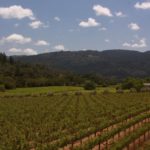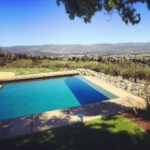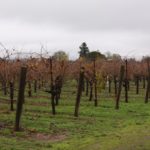Spring
 There are a number of factors that determine when a grapevine starts to break dormancy (bud break) which is when new green shoots start forming. Elevation, location, and the variety of the grape are some of the biggest factors that indicate when a vine will start bud break. During March and April temperatures at 32 degrees Fahrenheit or below will kill the new growth. This is very bad for winemakers as these buds contain what will become the wine grapes.
There are a number of factors that determine when a grapevine starts to break dormancy (bud break) which is when new green shoots start forming. Elevation, location, and the variety of the grape are some of the biggest factors that indicate when a vine will start bud break. During March and April temperatures at 32 degrees Fahrenheit or below will kill the new growth. This is very bad for winemakers as these buds contain what will become the wine grapes.
March and April are critical months because of the potential for frost; vineyard managers have several weapons at their disposal. Wind fans which sound like jet engines when they go on helps circulate and lower the warmer air above the vineyards to displace the colder air close to the ground. Some wineries use water to keep the small buds from freezing – essentially water freezes around the bud but not the bud itself.
By late spring the days and nights are warming up – and new growth is measured in inches per day. Bloom has occurred (yes grapes bloom but the flowers are small and not that exiting to see unless you look at them close up). The grapes are very small and look nothing like the mature fruit.
Summer
 The Napa Valley boasts a diversity of micro climates in a rather small area (32 miles long and only several miles wide in the widest parts of the valley). The southern part of the valley borders the San Pablo Bay and receives cooling influences from the water including fog, lower temperatures and often breezy conditions. This determines what types of grapes you grow here – mostly white varietals that like this type of weather. Compare that to much further up valley where the moderating influences of the bay are felt less – its warmer here, often 10-15 degrees more on a summer day and there is less fog. Red varietals such as Cabernet Sauvignon and Merlot do well here.
The Napa Valley boasts a diversity of micro climates in a rather small area (32 miles long and only several miles wide in the widest parts of the valley). The southern part of the valley borders the San Pablo Bay and receives cooling influences from the water including fog, lower temperatures and often breezy conditions. This determines what types of grapes you grow here – mostly white varietals that like this type of weather. Compare that to much further up valley where the moderating influences of the bay are felt less – its warmer here, often 10-15 degrees more on a summer day and there is less fog. Red varietals such as Cabernet Sauvignon and Merlot do well here.
Summer is the period of the season where the grapes develop on the vine – they mature and go through what is called “veraison” the changing of the skin from green to red (in red varietals) or becoming more translucent in the white varietals. Summer is a dry season in the Napa Valley – often fog rolls in during the early morning and clears out by mid morning to mid day making way for bright sunshine.
Elevation of vineyards also plays a critical role especially in summer. Certain elevations are above the fog line and overall receive more sunshine during the growing season. “Vineyards with a view” or hillside vineyards are at an elevation which can have different temperatures compared to the valley floor. Perhaps warmer during the morning when the fog is lower, and then cooling in the afternoon when the valley floor is warmer.
By mid August the varietals of grapes used to make sparkling wines are usually being harvested – sparkling wine does not require grapes to be picked at higher sugars so these can be picked earlier in the season.
Fall
 Harvest itself is a fun and absolutely crazy time to be in the valley (especially if you are in the industry). There is an air of excitement in the Napa area that you can only have during harvest time; loaded trucks with bins of grapes are flying down the roads to winery facilities, barrels and tanks are constantly moving around, walk into a wine lab and smell the unmistakable odor of yeast, enology & viticulture consultants find that their cell phones are invariably an extension of their head, and around the wineries, you can smell the awesome sweet smell of grapes and fermenting juice.
Harvest itself is a fun and absolutely crazy time to be in the valley (especially if you are in the industry). There is an air of excitement in the Napa area that you can only have during harvest time; loaded trucks with bins of grapes are flying down the roads to winery facilities, barrels and tanks are constantly moving around, walk into a wine lab and smell the unmistakable odor of yeast, enology & viticulture consultants find that their cell phones are invariably an extension of their head, and around the wineries, you can smell the awesome sweet smell of grapes and fermenting juice.
When a vineyard is ready to be picked – determined both by taste and tests in the lab (sugar, pH, acidity etc) – the grapes will usually be brought into the winery in the early morning when they are still cold. There are many different styles of how to make wine once the fruit reaches the winery.
Typically the grapes will go through a crusher/destemmer machine that removes the stems, leaving whole individual grapes. The grapes are placed in a bin or tank and often “cold soak” for several days (at a certain temperature) before commercial yeast is then added which starts fermentation. Wine takes its color and flavor from the skins – if you press a red grape between your fingers the juice is white. During fermentation the seeds and skins will rise to the top – to get color, flavor and structure into a wine a “punchdown” tool is used several times a day during fermentation to mix up the fermenting juice with the skins.
Red varietals often take 10-14 days before fermentation is complete (sugar is turned to alcohol). The wine is then referred to as being “dry” no sugar and an “extended maceration” may occur in which the grapes are allowed to continue to soak picking up additional characteristics from the skins.
Later a secondary fermentation will occur (temperature dependent) in which malic acid is converted to lactic acid. This in part helps soften the wine, enhances flavor and structure.
By late October the valley is a patchwork quilt of grapevines that radiate yellow, gold and red leaves. Usually by early to Mid November the valley sees its first frost – and after the first “hard” frost the colored leaves dry out and change from bright colors to a dullish grey. Later in Fall the leaves fall off helped in part by the rains that usually start in November.
Winter
 In Napa the temperatures during this season often get below freezing at night but this does not damage the grape vines as they are dormant.
In Napa the temperatures during this season often get below freezing at night but this does not damage the grape vines as they are dormant.
Pruning occurs by late winter; this involves cutting off much of the growth and branches that developed during the spring and summer months. A big reason for pruning is to limit the overproduction of vegetation so that the vine puts its energy into developing grapes rather than vegetation.
The grapevine wood that is cut during pruning can be mulched up and tilled back into the soil for additional nutrients.
There is always something to do when you are involved in an agricultural based industry, but winter can be the slowest time of the year for vintners. However there is always work to be done in the winery – lab tests must be conducted to make sure the wine is aging properly (sulphite tests, acidity tests etc). A process called “racking” also occurs. Racking temporarily moves wine out of its barrel to clean the “lees” out of the barrel (sediments, expired yeasts). Wine evaporates continuously through barrels and “topping up” is when barrels are filled to the surface from wine taken out of smaller containers.
Bottling can be done anytime of the year (vintners try to avoid doing this during harvest due to additional time constraints). If a winery is large enough it will have its own bottling equipment. A bottling line is expensive and smaller wineries often hire “mobile” bottling trucks which come directly to the winery and bottle the wine there.



Leave a Reply